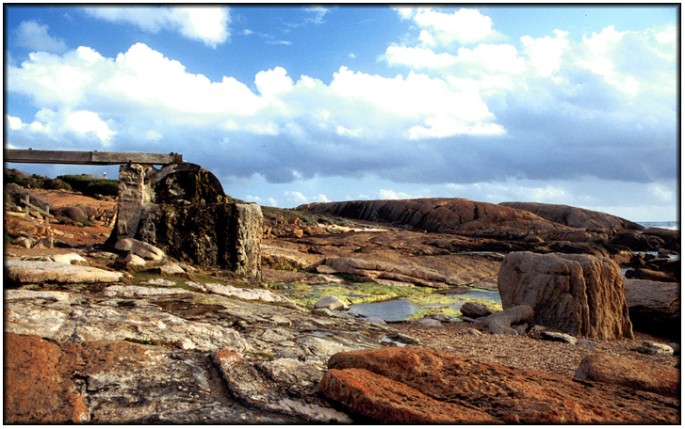Cape Leeuwin - Augusta, Western Australia

Lighthouse category: coastal Position: 34° 22.5'S : 115° 8.3'E Status: active Date: 1896 Designer: William Douglass Tower height: 128 feet Construction: round limestone tower with lantern and gallery Colour scheme: white Focal plane height: 185 feet Characteristics: white flash every 7.5 seconds Foghorn: none Google map view: google map link |
Actually, despite appearances to the contrary, there is a lighthouse in this photo. Just to the left of the waterwheel and immediately below the wooden flume on the top you can just see the very top of the lantern! In the course of a two week visit to Western Australia, this represents my biggest pharological cock up. We had checked into a local motel late in the afternoon and I had decided to nip out quickly to get a photograph or two of the old waterwheel, hopefully with some kind of sunset in the background. The sunset wasn't too successful, but I managed to get a few shots of the waterwheel. I had parked in the car park for the lighthouse, which was some considerable distance away from the parking area, and when I returned to the car in rapidly fading light, I discovered that the site was closed for the day. Not only that, but I had left my long zoom in the motel so I didn't have the reach to achieve anything usable "through the fence". So an unrepeatable opportunity was missed by a combination of stupidity and lack of forethought. Still, a valuable lesson was learned - always get the important photographs first!
Although little of what I have to say about Cape Leeuwin light will be noticeable from the above photograph, here it is nevertheless. The tower is twice the height of its near neighbour at Cape Naturaliste, but it's method of construction using roughly dressed blocks of limestone is very similar. It was designed by the famous British architect, William Tregarthen Douglass. Like Cape Naturaliste, the tower was originally unpainted, the colour of the tower being that of its construction material, Tamala limestone - the white paint scheme was applied only in 2003/04. In 1983, Cape Leeuwin became the last working light in Australia to be converted from kerosene to electricity. The light in use is a 2nd order Chance Brothers Fresnel lens and, again like Naturaliste, this floats in a mercury bath and was originally driven by clockwork until the conversion to electricity in 1983. The water wheel in the photograph was used to drive a hydraulic pump which pumped the fresh water from the flume to the lighthouse and associated keepers' cottages. The wheel is, of course, now disused and, because of the hardness of the water source, it has become almost totally calcified although the water still flows through the original wooden flume.
Cape Leeuwin itself is, like Cape Horn and the Cape of Good Hope, a true cape in the geographical definition of the word - that is to say that it marks the point of transition between two major bodies of water, in this case the great Southern Ocean to the south and the Indian Ocean to the west and north. The photograph below shows the view looking north along the coast with the waterwheel just visible in the right of shot.
.jpg.opt684x438o0,0s684x438.jpg)